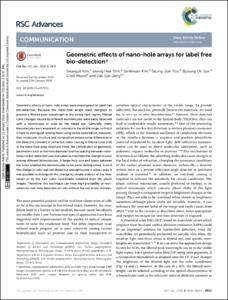Full metadata record
| DC Field | Value | Language |
|---|---|---|
| dc.contributor.author | Kim, Seunguk | - |
| dc.contributor.author | Shin, Jeong Hee | - |
| dc.contributor.author | Kim, Samhwan | - |
| dc.contributor.author | Yoo, Seung-Jun | - |
| dc.contributor.author | Jun, Byoung Ok | - |
| dc.contributor.author | Moon, Cheil | - |
| dc.contributor.author | Jang, Jae Eun | - |
| dc.date.available | 2017-05-11T01:35:19Z | - |
| dc.date.created | 2017-04-10 | - |
| dc.date.issued | 2016 | - |
| dc.identifier.citation | RSC Advances, v.6, no.11, pp.8935 - 8940 | - |
| dc.identifier.issn | 2046-2069 | - |
| dc.identifier.uri | http://hdl.handle.net/20.500.11750/1558 | - |
| dc.description.abstract | Geometric effects of nano-hole arrays were investigated for label free bio-detection. Because the nano-hole arrays were designed to present a filtered peak wavelength in the visible light region, filtered color changes caused by different biomolecules were easily observed with a microscope or even by the naked eye. Generally, many biomolecules are transparent or colorless in the visible range, so that it is hard to distinguish among them using visible observation. However, their molecular structure and composition induce some differences in the dielectric constant or refractive index causing a filtered color shift in the nano-hole array structure. Here, the contribution of geometric parameters such as the hole diameter and the spacing between nano-holes for bio-detection was evaluated to maximize the change in color among different biomolecules. A larger hole size and space between the holes enabled the biomolecules to be easily distinguished. Even if the change in color was not distinctive enough by eye in some cases, it was possible to distinguish the change by simple analysis of the 'Hue' values or by the 'Lab' color coordinates obtained from the photo images. Therefore, this technique can have high probability of realization for real-time detection of cells without the use of bio-markers. © The Royal Society of Chemistry 2016. | - |
| dc.language | English | - |
| dc.publisher | Royal Society of Chemistry | - |
| dc.title | Geometric effects of nano-hole arrays for label free bio-detection | - |
| dc.type | Article | - |
| dc.identifier.doi | 10.1039/c5ra25797b | - |
| dc.identifier.wosid | 000369515900049 | - |
| dc.identifier.scopusid | 2-s2.0-84957007027 | - |
| dc.type.local | Article(Overseas) | - |
| dc.type.rims | ART | - |
| dc.description.journalClass | 1 | - |
| dc.citation.publicationname | RSC Advances | - |
| dc.contributor.nonIdAuthor | Kim, Seunguk | - |
| dc.contributor.nonIdAuthor | Shin, Jeong Hee | - |
| dc.contributor.nonIdAuthor | Kim, Samhwan | - |
| dc.contributor.nonIdAuthor | Yoo, Seung-Jun | - |
| dc.contributor.nonIdAuthor | Jun, Byoung Ok | - |
| dc.identifier.citationVolume | 6 | - |
| dc.identifier.citationNumber | 11 | - |
| dc.identifier.citationStartPage | 8935 | - |
| dc.identifier.citationEndPage | 8940 | - |
| dc.identifier.citationTitle | RSC Advances | - |
| dc.type.journalArticle | Article | - |
| dc.description.isOpenAccess | Y | - |
| dc.subject.keywordPlus | Biomarker | - |
| dc.subject.keywordPlus | Biomolecules | - |
| dc.subject.keywordPlus | Color | - |
| dc.subject.keywordPlus | Color Coordinates | - |
| dc.subject.keywordPlus | Geometric Effects | - |
| dc.subject.keywordPlus | GEOMETRY | - |
| dc.subject.keywordPlus | High Probability | - |
| dc.subject.keywordPlus | Light | - |
| dc.subject.keywordPlus | Nanohole Arrays | - |
| dc.subject.keywordPlus | Peak Wavelength | - |
| dc.subject.keywordPlus | Real-Time Detection | - |
| dc.subject.keywordPlus | Refractive Index | - |
| dc.subject.keywordPlus | Resonance | - |
| dc.subject.keywordPlus | Sensors | - |
| dc.subject.keywordPlus | Simple Analysis | - |
| dc.subject.keywordPlus | TRANSMISSION | - |
| dc.subject.keywordPlus | Visible Light Region | - |
| dc.contributor.affiliatedAuthor | Kim, Seunguk | - |
| dc.contributor.affiliatedAuthor | Shin, Jeong Hee | - |
| dc.contributor.affiliatedAuthor | Kim, Samhwan | - |
| dc.contributor.affiliatedAuthor | Yoo, Seung-Jun | - |
| dc.contributor.affiliatedAuthor | Jun, Byoung Ok | - |
| dc.contributor.affiliatedAuthor | Moon, Cheil | - |
| dc.contributor.affiliatedAuthor | Jang, Jae Eun | - |
- Files in This Item:
-
 기타 데이터 / 1.53 MB / Adobe PDF
download
기타 데이터 / 1.53 MB / Adobe PDF
download



